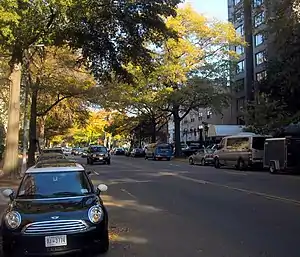Rhode Island Avenue
Rhode Island Avenue is a diagonal avenue in the Northwest and Northeast quadrants of Washington, D.C., and the capital's inner suburbs in Prince George's County, Maryland.[1] Paralleling New York Avenue, Rhode Island Avenue was one of the original streets in Pierre L'Enfant's plan for the capital.[1] It became a major commuter route, carrying U.S. Route 1 traffic into the city from Prince George's County.
| |
 1400 block of Rhode Island Ave NW, in the Logan Circle neighborhood | |
| Namesake | Rhode Island |
|---|---|
| Maintained by | DDOT |
| Location | Washington, D.C., U.S. |
| Coordinates | 38°55′14.65″N 76°59′52.15″W |
| West end | Connecticut Avenue |
| Major junctions | |
| East end | |
The western terminus of Rhode Island Avenue is in downtown Washington, at an intersection with Connecticut Avenue NW and M Street NW.[1] The Cathedral of St. Matthew the Apostle is on Rhode Island Avenue NW, just east of that intersection.[1] Just east of the cathedral, at Scott Circle, Rhode Island Avenue NW intersects Massachusetts Avenue NW and 16th Street NW. N Street NW stops short of meeting the circle from either direction, but is instead connected to Rhode Island and Massachusetts avenues NW through two short streets, Corregidor Street NW and Bataan Street NW. From Scott Circle, Rhode Island Avenue NW continues eastward to the Logan Circle neighborhood. At the traffic circle of the same name, Rhode Island Avenue NW intersects Vermont Avenue, 13th Street, and P Street NW.
East of Logan Circle, Rhode Island passes through primarily residential neighborhoods such as Bloomingdale, Shaw and Brentwood. Rhode Island Avenue is U.S. Route 29 between 7th and 11th streets NW, and U.S. Route 1 east of 6th Street NW. In Northeast Washington, Rhode Island Avenue NE is served by the Rhode Island Avenue–Brentwood station on the Red Line and the Shaw–Howard University station on the Green Line of the Washington Metro.
In 1926, Rhode Island Avenue NE was extended from the District line into Maryland, through Mount Rainier, Brentwood, and North Brentwood.[2]
In downtown Hyattsville, Rhode Island Avenue merges into Baltimore Avenue (U.S. Route 1 Alternate). U.S. Route 1 traffic continues north on Baltimore Avenue. Discontinuous segments of Rhode Island Avenue exist in Riverdale Park, College Park, and Beltsville, running along or alongside the abandoned Washington, Berwyn and Laurel Electric Railroad.
References
- Historic American Buildings Survey, creator (1993). Rhode Island Avenue, Washington, District of Columbia, DC (PDF). pp. 1–9 – via Library of Congress Prints and Photographs Division.
{{cite book}}:|work=ignored (help) - "Mt. Ranier Favors Plan of Extending Rhode Island Ave.: Mayor and Council Formally Approve Project and Map Action". The Washington Post. August 5, 1926. p. 2. ProQuest 149605154.
External links
 Media related to Rhode Island Avenue (Washington, D.C.) at Wikimedia Commons
Media related to Rhode Island Avenue (Washington, D.C.) at Wikimedia Commons- Historic American Buildings Survey (HABS) No. DC-708, "Rhode Island Avenue", 8 photos, 9 data pages, 1 photo caption page
 Geographic data related to Rhode Island Avenue at OpenStreetMap
Geographic data related to Rhode Island Avenue at OpenStreetMap